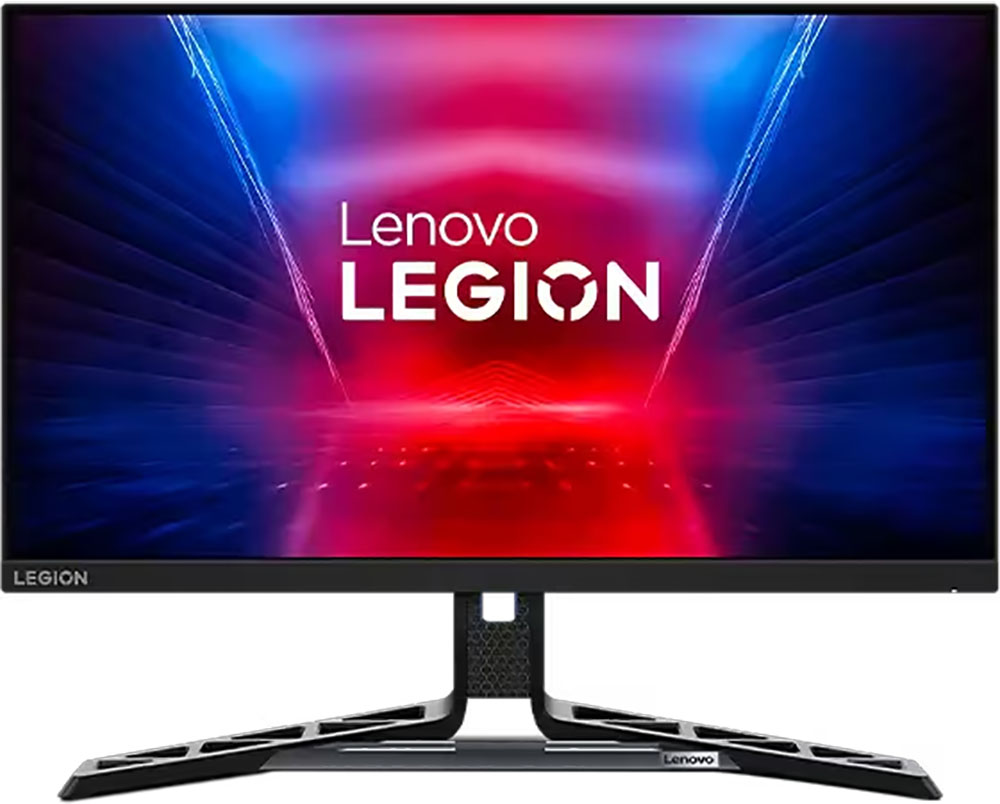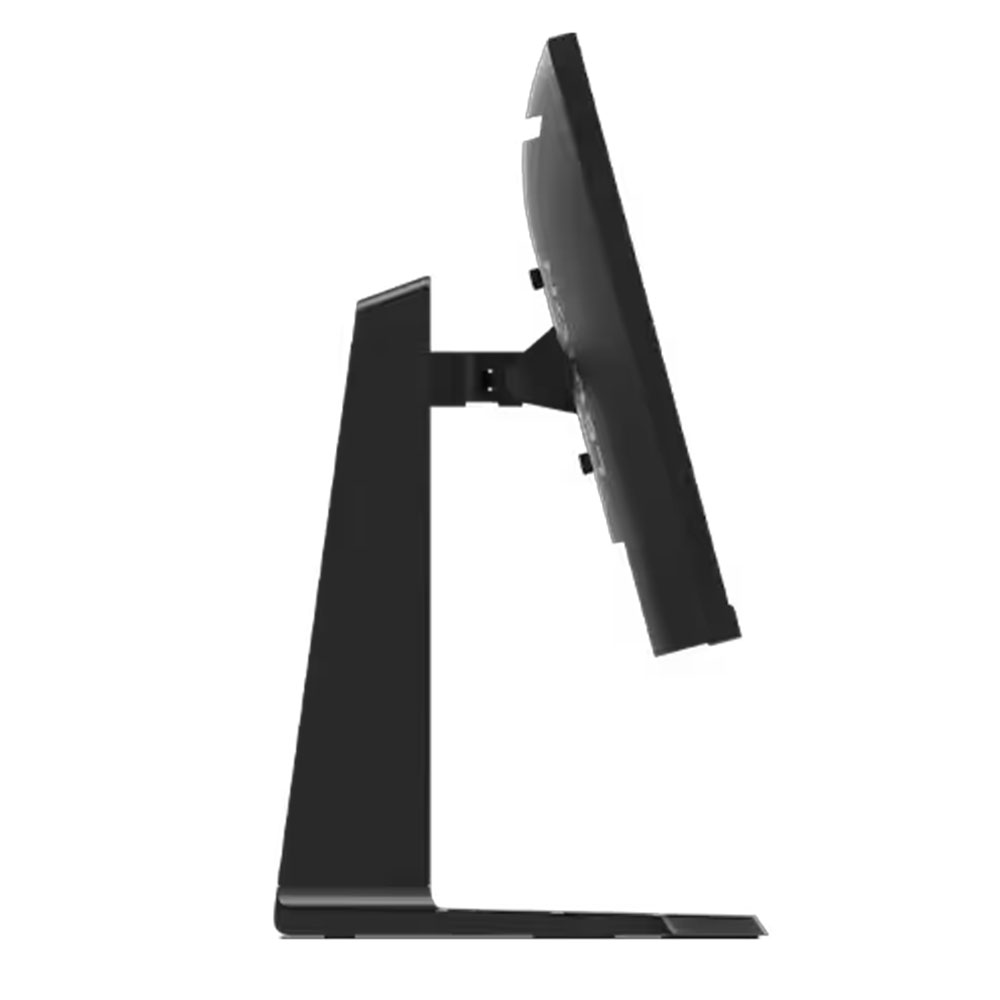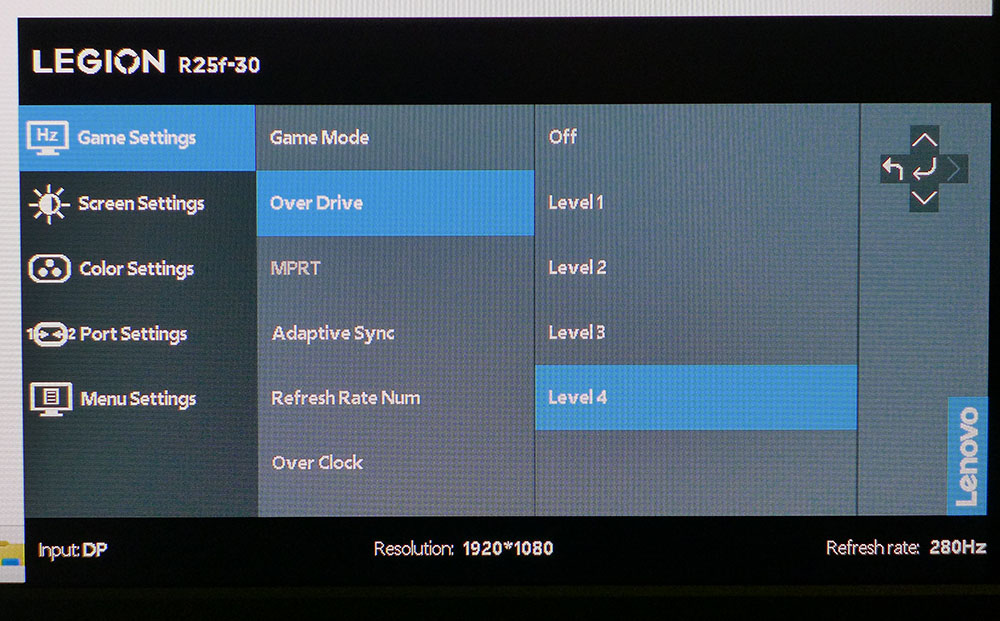Tom's Hardware Verdict
Among budget monitors there are few, if any, better than the Lenovo Legion R25f-30. It delivers superb contrast, a colorful image and premium video processing for an excellent gaming experience.
Pros
- +
Excellent contrast
- +
Decent out-of-box color accuracy, made better with calibration
- +
Larger color gamut than most budget displays
- +
Superb video processing with low input lag and precise overdrive
- +
Solid build quality
- +
Phenomenal value
Cons
- -
Warm grayscale in HDR mode
- -
No extra contrast for HDR content
Why you can trust Tom's Hardware
With so much attention focused on the best gaming monitors thanks to hyper-fast screens and OLED technology, it’s always good to remember that genuinely excellent performance is available at the opposite end of the spectrum. While $1,000 will buy you a fantastic display, $162 can put a very nice 25-inch 280 Hz monitor on your desk. I’m talking about Lenovo’s Legion R25f-30, a VA panel with FHD resolution, Adaptive-Sync and wide gamut color. Let’s take a look.
Lenovo Legion R25f-30 Specs
| Panel Type / Backlight | VA / W-LED, edge array |
| Screen Size / Aspect Ratio | 25 inches / 16:9 |
| Max Resolution and Refresh Rate | 1920x1080 @ 240 Hz |
| Row 3 - Cell 0 | 280 Hz w/overclock |
| Row 4 - Cell 0 | FreeSync and G-Sync Compatible |
| Native Color Depth and Gamut | 8-bit / DCI-P3 |
| Response Time (GTG) | 1ms |
| Brightness (mfr) | 350 nits |
| Contrast (mfr) | 3,000:1 |
| Speakers | 2x 3w |
| 2x 3w | 1x DisplayPort 1.4 |
| Row 11 - Cell 0 | 2x HDMI 2.1 |
| Audio | 3.5mm headphone output |
| USB | None |
| Power Consumption | 17.4w, brightness @ 200 nits |
| Panel Dimensions WxHxD w/base | 21.9 x 14.3-19.6 x 10.2 inches (556 x 363-498 x 259mm) |
| Panel Thickness | 2 inches (51mm) |
| Bezel Width | Top/sides: 0.2 inch (6mm) |
| Row 18 - Cell 0 | Bottom: 0.7 inch (19mm) |
| Weight | 12.1 pounds (5.5kg) |
| Warranty | 3 years |
Much of a gaming monitor’s feel comes from motion processing, which can be accomplished with high refresh rates and premium tech. The R25f-30 achieves a smooth feel with a 280 Hz overclocked panel equipped with a precise overdrive. You also get Adaptive-Sync, which works on FreeSync and G-Sync platforms, as well as consoles. It has not been certified by Nvidia, but it ran G-Sync all day during my tests. I’ll use the phrase “surprisingly good performance” just once because the price at this writing is a paltry $162.
Though some might pause at its FHD (1920x1080) resolution, the panel size means a density of 90ppi, which is enough for a sharp image that doesn’t show its dot structure until your nose practically touches the screen. There is plenty of light output, with over 370 nits measured in my tests and around 340 for HDR content. There is no extra contrast there, but the native dynamic range for SDR and HDR is on the high end of VA territory at around 3,500:1. The picture pops, and there is plenty of color, with 90% measured coverage of the DCI-P3 gamut.
Gamers will enjoy a well-stocked OSD that has an excellent overdrive, MPRT (backlight strobe), multiple game-specific picture modes, and a frame rate counter. You also get a pair of internal speakers, but there are no USB ports. The R25f-30 also forgoes LED lighting though given the diminutive price tag, but that is no surprise.
Build quality is solid, with a fully adjustable stand and rugged construction. You also get two HDMI 2.1 ports along with a DisplayPort 1.4 and a headphone jack. The OSD is navigated by a handy joystick or by Lenovo’s Artery app that controls everything from the Windows desktop. The R25f-30 is a seriously good gaming monitor for $162. It would be easy to stop there and say “buy it,” but what fun would that be?
Assembly and Accessories
Lenovo embraces the latest recyclable packaging with a clamshell box and molded pulp insides to protect the R25f-30. It ships in three parts that assemble without tools. The panel attaches to the upright with four large knurled thumb screws. The internal power supply is fed by an included IEC cord, and you get a DisplayPort cable.
Product 360




The R25f-30 has one of the thinnest flush bezels I’ve yet seen. It’s only six millimeters wide at the top and sides and 19mm at the bottom. The anti-glare layer works well at maintaining image quality in bright rooms without introducing any grain. The word Legion appears at the lower left while a tiny LED glows at the right, white for power on and orange in standby.
Get Tom's Hardware's best news and in-depth reviews, straight to your inbox.
The stand has Lenovo’s distinct industrial look with a girder pattern in the large base and honeycomb textures on the upright. There’s a bit of blue trim in the cable hole along with Lenovo and Legion logos silkscreened on the back. The chassis is solid and over-engineered for the R25f-30’s relatively lightweight.
Ergonomics include 5/22 degrees tilt, 30 degrees swivel and a generous 5.3-inch height adjustment. You also get a 90-degree portrait mode. Movements are very firm, as if the monitor were heavier. I expect some usage will be required to make them smoother. But the R25f-30 stays put once adjusted. You can also set the screen at eye level while making it perpendicular to the desktop.
The port panel is sparse, with just two HDMI 2.1 and one DisplayPort 1.4 plus a 3.5mm headphone jack. There are no USB ports, but you get a decent pair of internal speakers. They are limited to upper midrange frequencies but play clearly at high volumes without audible distortion.
OSD Features
The R25f-30’s OSD has clear text with a dark background for good visibility and is all business. It’s divided into five sections and appears when you click the joystick. Two additional keys take you straight to picture modes and input selection.






All OSD screens show basic signal info at the bottom. The Game Settings menu has seven picture modes, of which Standard is the default and best choice. It allows access to all calibration controls, including color temp and gamma presets. There is a four-level overdrive that can be used effectively on its maximum setting if you’re running over 240 Hz. To engage that rate, turn on the overclock option. I noted that the R25f-30 automatically reverts to 240 Hz after 30 minutes. This option cannot be defeated, which is a minor annoyance. A frame rate counter is included, but there are no aiming points. For systems running at slower frame rates, below 120fps, you can use the MPRT backlight strobe as an alternative to Adaptive-Sync. It shows a slight phasing artifact in test patterns, but in practice, it’s one of the better implementations I’ve seen.
The Screen Settings menu has basic picture controls like brightness and contrast, along with dynamic contrast, HDR (Auto or off), and a Dark Boost setting to enhance shadow detail. The R25f-30’s excellent VA panel does not need help rendering detail in any part of the image, so I recommend leaving these off. On the second screen of this menu, you’ll find Sharpness (leave it on 40) and the gamma settings. Rather than labeling them with the traditional 2.2/2.4 terms, they have correction factors. The default gamma is too light, as you’ll see in the test results, so I recommend dialing in a +0.2 correction to compensate.
If you need an sRGB mode, it is among the R25f-30’s color temp presets. All of them are fixed except the User mode which has precise RGB sliders. I used them to achieve a more precise calibration.
Lenovo Legion R25f-30 Calibration Settings
The R25f-30’s Standard mode has everything necessary for an accurate image calibration. You can use the monitor as is, but I recommend at minimum that you add a gamma correction of +0.2. The default setting is a bit light, which washes out the image. The VA panel used here is very good and has adequate contrast to support a darker gamma. With a few tweaks to the RGB sliders in the User color temp, an excellent picture can be achieved. My SDR settings are below.
HDR content signals an automatic switch if HDR is set to Auto. You can turn it off if you wish. There are no image options available, but I found reasonably close compliance with industry standards. Sadly, there is no dimming here, so contrast is the same as it is for SDR.
| Picture Mode | Standard |
| Brightness 200 nits | 73 |
| Brightness 120 nits | 42 |
| Brightness 100 nits | 31 |
| Brightness 80 nits | 9 (min. 74 nits) |
| Contrast | 75 |
| Gamma | +0.2 |
| Color Temp User | Red 96, Green 97, Blue 100 |
Gaming and Hands-on
It’s easy to be seduced by high resolution screens when playing slow-moving visual feasts such as Myst, but for high-speed combat, smooth and quick response is the most important contributor to success. Precision movement and aiming in run-and-gun maneuvers is so much easier when you have a monitor that can keep up. I’ll always choose a 240 Hz OLED, but if you don’t have $1,000 to spend, the R25f-30 is the next best thing. I don’t say that lightly. You can buy a number of monitors that run at 360 and 500 Hz. And they’ll be a little better, but not three or four times better. For gaming on a budget, this is where it’s at.
I played hours of Doom Eternal and racked up frags with ease. Classic moves like circle strafe and reverse shooting were child’s play. The R25f-30’s overdrive is super clean and removes nearly all motion blur. You won’t need an expensive PC to max the frame rate at 280. I played on a GeForce RTX 4090 equipped system and its cooling fans never turned above idle speed. Adaptive-Sync worked perfectly as well. I tried MPRT for a bit and found it effective. It didn’t remove any more blur than G-Sync with overdrive, but it would be useful for systems running below 120fps.
The picture was very colorful and deeply textured. VA panels are the next best way to create a realistic image after OLED. The R25f-30 delivers over 3,500:1 native contrast, so its black levels are deep and true, with plenty of clear shadow detail. I never found the need for the Shadow Boost option. It’s important to change the gamma setting to +0.2 to achieve the most satisfying image.
For productivity, if I had to use an FHD monitor, I would opt for this smaller size. I’ve tried many 27-inch monitors and even a few 32s and their pixel density is too low to render fine photo detail and text effectively. These things are not a problem for the R25f-30. I could not see the dot structure nor any jagged lines to distract from the workday.
I also noted the excellent sound from the internal speakers. While they won’t shake your desk with stupendous bass, they are super clean and more detailed than most. I ran the volume at 50% and could hear everything clearly without disturbing anyone in the next room. Maxing the slider gave me more than enough presence and there was no distortion.
Takeaway: The R25f-30 is an impressively capable gaming and general-use monitor. Video processing is as good as the best LCD panels I’ve reviewed, and image quality is first-rate. There’s plenty of contrast and color saturation, and pixel density is high enough to eliminate any grain or visible dot structure. For the money, it’s nearly in a class by itself.
MORE: Best Gaming Monitors
MORE: How We Test PC Monitors
MORE: How to Buy a PC Monitor
MORE: How to Choose the Best HDR Monitor
Current page: Features and Specifications
Next Page Response, Input Lag, Viewing Angles and Uniformity
Christian Eberle is a Contributing Editor for Tom's Hardware US. He's a veteran reviewer of A/V equipment, specializing in monitors. Christian began his obsession with tech when he built his first PC in 1991, a 286 running DOS 3.0 at a blazing 12MHz. In 2006, he undertook training from the Imaging Science Foundation in video calibration and testing and thus started a passion for precise imaging that persists to this day. He is also a professional musician with a degree from the New England Conservatory as a classical bassoonist which he used to good effect as a performer with the West Point Army Band from 1987 to 2013. He enjoys watching movies and listening to high-end audio in his custom-built home theater and can be seen riding trails near his home on a race-ready ICE VTX recumbent trike. Christian enjoys the endless summer in Florida where he lives with his wife and Chihuahua and plays with orchestras around the state.
